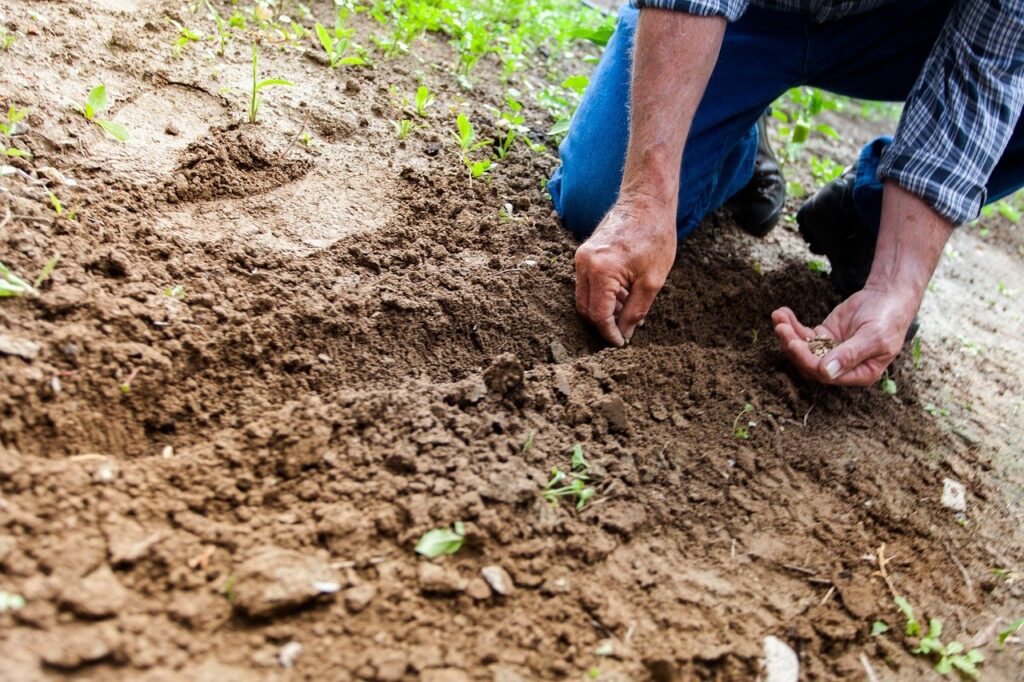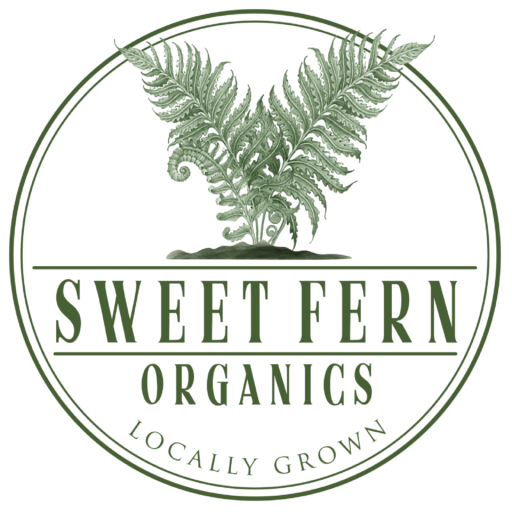When you started researching fertilizer and soil health on a market farm, you probably came across the term green manure. Heck, you clicked on this article, right?
I had no idea what green manure was before I started researching all about market farming, and I definitely did not know how to use it!
My goal is that by the time you are finished reading this article, you will in fact know what green manure is, why it is important to your soil, and how you can use it on your market farm.
Full disclosure, much of the information found in this article is from Eliot Coleman’s The New Organic Grower, where he has a whole chapter dedicated to green manure. Awesome!
What Is Green Manure?
Green manures are grown not for cash but to contribute to the care and feeding of the soil.
A green manure crop incorporated into the soil improves fertility, with eventual benefits that are far greater than just soil fertility.
Green manure crops help protect against erosion, retain nutrients that might otherwise be leached from the soil, suppress germination and growth of weeds, cycle nutrients from the lower to the upper layers of the soil, and leave to the following crop a considerable quantity of nitrogen.
Green manure also contributes to improved soil structure, additional organic matter, enhanced drought tolerance, and increased nutrient availability for plants.
Wow! That’s a lot of benefits. Makes you want to learn more about green manures, right?
No worries, I got you covered!
Why is Adding Green Manure To Soil So Significant?
Like crop rotation, green manures represent a management benefit; they are a farm-generated production aid that offers an excellent return from little effort or expense, just the price of seeds.
When green manures are included in the overall soil management program, the combination of green manures and crop rotation can result in a truly unbeatable vegetable production system.
Benefits Of Green Manure
The benefits of using green manure on your market farm are many, let me tell you.
Here is a general overview of the benefits provided by green manure on your soil.
Inexpensive Nitrogen
Leguminous green manures are an inexpensive source of nitrogen.
The nitrogen is produced right where it is needed, in the soil. When leguminous green manures are used effectively, any additional application of nitrogen is often unnecessary.
The symbiotic process by which leguminous plants fix nitrogen from the air depends on a number of factors for its success, including:
- Soil pH of 6.5-6.8
- Proper rhizobium bacteria must be present in the soil – a bacterial inoculant should be applied if there is any doubt (purchased from farm stores or seed catalogs)
- Soil test for trace elements of molybdenum (Mo) and cobalt (Co) should be done as these are important catalysts for symbiotic nitrogen fixation, so it’s important to know if they are present in your soil or not

Humus
Humus is the end product of organic matter decay in the soil.
It is the key to good soil structure, nutrient availability, moisture supply, and the biological vitality of the soil.
Some forms of green manure residues are more long-lasting than others.
Very young, sappy green growth will stimulate a lot of activity in the soil but will not contribute much, if anything, to long-lasting humus. For example, a 2 or 3” growth of recent sown oats or clover.
Old, dry residues take longer for the soil process to digest but are more valuable in building humus reserves. An example would be brown, frosted, and dried out corn stalks.
Lush green manure is better mowed and left to wilt for a day or two before being incorporated into the soil, to help slow down what could be a too rapid decomposition.
The tough, mature crops will decompose faster if they are chopped or shredded before they are incorporated into the soil.
Stable Nutrients
Plant nutrients can be lost from unprotected soil.
During fall, winter, and early spring, when commercial crops are not in the field, the growing green manure crops will not only hold the soil against erosion, but their roots will capture and use available plant nutrients that might otherwise be leached away.
In addition to the nitrogen nodules on the roots of legumes, green manures provide further contributions to the mineral nutrition of subsequent crops.
The green manure plants themselves, once decomposed by soil organisms, provide the most direct contribution.
An indirect contribution results when the process of decomposition aids in making further nutrients available.
Decaying organic matter can make available otherwise insoluble plant nutrients in the soil through the action of decomposition products such as carbon dioxide and acetic, butyric, lactic, and other organic acids.
Carbon dioxide is the end product of energy used by soil microorganisms.
Increasing the carbon dioxide content of the soil air as a result of decomposition of plant residues increases the carbonic acid activity, thus speeding up the process of bringing soil minerals into solution.
As well, soil microorganisms are stimulated by the readily available carbon contained in the fresh plant material, and their activity results in speeding up the production of ammonium and nitrate.
Even soils naturally high in organic matter, such as peats or mucks, are improved by the incorporation of a green manure crop, which makes them more biologically active.
Biological Subsoilers
Where soil compaction exists, deep rooting green manures can bring a miraculous improvement in subsequent crops, solely by penetrating and shattering the subsoil with their roots.
This opens the soil, permitting the crop roots to more easily reach lower soil levels, where they find greater supplies of water and nutrients.
How Is Green Manure Used?
There are three ways in which green manure crops can be managed, overwinter crops, main crops, and undersown crops. Let’s explore.
Overwintered Green Manures
Green manures can be sown for overwintering after a market crop has been harvested.
For example, leguminous green manure could be sown after the pea harvest which would occupy the ground until it was tilled in the following spring prior to planting cabbages.
This provides ideal growing conditions for next year’s crop.
Main Crop Green Manures
The green manure occupies ground in place of a market crop during the growing season or, even better, for up to three years.
If extra land is available, this is a highly recommended practice, and, when the green manure crop can be grazed by livestock, it serves a double purpose.
This is where the grower has to make a choice, to put all land into market crops at the expense of the soil OR reap the future benefits of the green manure crop at the expense of a market crop (income).
Luckily, there is a third option that allows the grower to have a leguminous green manure crop and the cash, known as undersowing.
Undersown Green Manures
Undersowing is also known as overseeding or companion seeding. It is the practice of growing green manure along with the market crop.
When done correctly, undersowing provides the best of both worlds.
The clover or other legumes are sown with or shortly after wheat or oats for example, and grow slowly in the understory until the grain crop is harvested.
The advantage of undersowing is that the green manure crop is already established at harvest time.
Properly using the undersowing technique takes some research and experience.
For the sake of this article, I am not going to go into full detail about the undersowing process. If you would like more explanation, let me know in the comments below, and be sure to check out The New Organic Grower by Eliot Coleman for his experience and expert advice.

Green Manure Crops List
Because green manure plants have different faults and virtues that affect the soil and following crops in different ways, green manures should be rotated to include as many different varieties as possible.
These are Eliot’s choices of green manure crops based on different uses.
- Tall Crops: sweet clover, vetch, red clover, alsike clover
- Sodlike cover: dwarf white clover
- Resistance to foot traffic in picking: dwarf white clover or vetch
- Before potatoes: soybeans or sweet clover
- Under corn: soybeans, sweet clover, or red clover
- Between rows of root crops: sweet clover or dwarf white clover
- Soil protection that will winter-kill: spring oats, spring barley, or in warmer climates, a winter legume that will complete its growth in spring and can be mowed off
- For the latest fall planting in cold climates: rye or winter wheat
Considerations When Choosing Green Manure Crops
Choosing the right green manure for your market farm is no easy task. Here are a few things to consider when making your choice.
- Time of seeding: early, late, intercrop, undersown, year-round?
- Establishment: the ideal crop is easy to establish and grows rapidly
- Time of incorporation into the soil: How mature is the green manure?
- Rotational fit: the green manure should not share susceptibility to diseases or insect damage in common with the crop plants
- Feed value: when green manure serves as animal feed, manure is deposited on the soil, and fertility is enhanced even more
- Soil microorganisms: which green manure best stimulates the biological activity of the soil?
- Beneficial insects: some green manures can serve as nurse crops for useful insects
- Cost: is the seed expensive? Can it be easily produced on the farm? Will the crop yield both seed and feed? Will a less costly seed be as effective if it is managed properly?
Bottom Line
Green manure is not an easy concept to understand. It takes a lot of time and practice to use it efficiently. None of the crops mentioned in this article are hard and fast rules.
The best innovations and improvements usually come from the grower themselves, not from any chart or list.
The more involved a grower becomes in taking charge and perfecting the green manure system, the more independent, reliable, and sustainable the system will become.
– Eliot Coleman
We fully intend on using green manures on our market farm, with the understanding that is going to take some years before we have a reliable (ever-evolving) system in place.
Let me know in the comments if you want more explanation on anything mentioned in this article.
Also if you use green manures, what is your experience with them?
Stay Local,
Kathy & Jon
your friendly neighbourhood growers


0 Comments